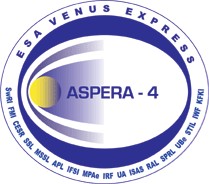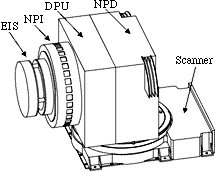|
ASPERA-4 - a VenusExpress Orbiter Instrument
Analyzer of Space Plasmas and EneRgetic Atoms
 ASPERA-4 is an advanced and compact ion, electron and neutral particle detector package developed for the Venus Express mission to investigate the plasma and neutral particle environment near Venus. ASPERA-4 will perform the first ever Energetic Neutral Atom (ENA) measurements at planet Venus in the low energy range (100 eV - 10 keV). The instrument is essentially identical to the
ASPERA-4 is an advanced and compact ion, electron and neutral particle detector package developed for the Venus Express mission to investigate the plasma and neutral particle environment near Venus. ASPERA-4 will perform the first ever Energetic Neutral Atom (ENA) measurements at planet Venus in the low energy range (100 eV - 10 keV). The instrument is essentially identical to the  ASPERA-3 instrument on ASPERA-3 instrument on  Mars Express. Mars Express.
Science objectives
The general scientific objective of ASPERA-4 is to study the solar wind - atmosphere interaction and to characterize the plasma and neutral gas environment in the near-Venus space through  Energetic Neutral Atom (ENA) Imaging and in-situ plasma measurements. ENA imaging is a novel technique to visualize and monitor processes in dilute gases. ENAs are produced via charge exchange processes between singly-charged ions and neutral gases of the exosphere / upper atmosphere. Due to their neutrality, ENAs are decoupled from the electromagnetic fields and propagate on straight paths like photons. Directional detection of the ENAs therefore yields a global image of the interaction region. Energetic Neutral Atom (ENA) Imaging and in-situ plasma measurements. ENA imaging is a novel technique to visualize and monitor processes in dilute gases. ENAs are produced via charge exchange processes between singly-charged ions and neutral gases of the exosphere / upper atmosphere. Due to their neutrality, ENAs are decoupled from the electromagnetic fields and propagate on straight paths like photons. Directional detection of the ENAs therefore yields a global image of the interaction region.
The specific objectives are:
-
The determination of the instantaneous global distributions of plasma and neutral gas near Venus
-
The study of plasma induced atmospheric escape
-
The investigation of atmospheric modifications through ion bombardment
-
The investigation of the energy deposition from the solar wind to the ionosphere and erosion of the ionosphere
These studies address the fundamental question why the atmospheres of Earth, Mars and Venus developed so differently. At Earth the atmosphere has always been protected by the magnetic field against erosion by the solar wind. At Mars the protection by a field vanished during the first 500 Million years after creation of the planet and after that the atmosphere has been almost completely lost. At Venus there are no traces of a primordial field (though the magnetometer on Venus Express might show differently) but the atmosphere was not eroded because of the higher gravity of Venus as compared to Mars. Still we know from previous misions that the Venus atmosphere has no traces of water. How the water has been lost is one of the questions our experiment tries to answer.
![[Top]](/images/icons/top.gif)
Instrument description
ASPERA-4 comprises four sensors:

-
 NPI (Neutral Particle Imager) NPI (Neutral Particle Imager)
measures the integral energetic neutral atoms flux with no mass and energy resolution but high angular resolution.
-
 NPD (Neutral Particle Detector) NPD (Neutral Particle Detector)
resolves mass (hydrogen and oxygen) and velocity (energy range 0.1 - 10 keV) of the ENA.
-
EIS (Electron and Ion Spectrometer)
determines the electron and ion distribution to energies up to 40 keV
-
IMA (Mass resolving Ion Analyser)
measures the main ion components (H+, H2+, He+, O+), molecular ions from 20 to 80 amu/q and up to 106 amu/q for dusty plasmas in an energy range from 100 eV to 40 keV/q.
To increase angular coverage NPI, NPD, and EIS are mounted on a scanning platform.
ASPERA-4 performance
| |
NPI |
NPD |
IMA |
EIS |
| Particles |
ENA |
ENA |
ions |
electrons |
| Energy, keV |
0.1 - 60 |
0.1 - 10 |
0.01 - 40 |
0.001 - 20 |
| Energy res. dE/E |
- |
80% |
10% |
7% |
| Mass res. |
- |
H, O |
M/dM = 5 |
- |
| FoV |
9° x 344° |
9° x 180° |
4.6° x 360° |
10° x 360° |
| Angular Res. (FWHM) |
4.6° x 11.5° |
5° x 30° |
5° x 22.5° |
5° x 22.5° |
| G-Factor/pixel, cm2 sr |
2.5 x 10-3 |
6.2 x 10-3 |
3.5 x 10-4 |
3 x 10-4 |
| Efficiency, % |
1 |
1 - 25 |
n/a |
n/a |
| Time res. for full 3D, s |
32 |
32 |
32 |
32 |
![[Top]](/images/icons/top.gif)
MPS contribution
ASPERA-4 is realized by a large international consortium of more than 10 European and US institutes. The  team is led by R. Lundin (Swedish Institute of Space Physics, Kiruna). The MPS, in cooperation with IDA (University Braunschweig) and IFSI, Rom, is supplying the electronics of the NPD sensor and will take part in the scientific data analysis. team is led by R. Lundin (Swedish Institute of Space Physics, Kiruna). The MPS, in cooperation with IDA (University Braunschweig) and IFSI, Rom, is supplying the electronics of the NPD sensor and will take part in the scientific data analysis.
![[Top]](/images/icons/top.gif)
Related links
|
